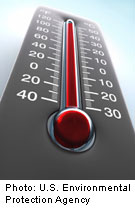
THURSDAY, March 7 (HealthDay News) — Cholesterol levels increase with winter’s arrival and drop again as warmer weather returns, a new study by Brazilian researchers suggests.
“In the winter, people should be careful with their cholesterol levels,” said lead researcher Dr. Filipe Moura, a doctoral student at the State University of Campinas.
Whether these changes in cholesterol are putting patients at risk for heart attacks or stroke isn’t clear, Moura said. It’s a complex picture and these changes might have a role, but there are many other factors, he added.
There are several possible reasons cholesterol varies by season, Moura said, including changes in diet, exercise and exposure to the sun.
“In the winter, people consume more calories and eat fattier foods, which could have an effect on their bad cholesterol,” he said. “Also, it’s common for people to exercise less during the winter and stay in more.”
People also get less sun in the winter, so they get less vitamin D, which can have an effect on cholesterol, Moura said. He also noted that during the winter people are prone to colds and the flu, which can effect cholesterol levels.
The study findings were scheduled to be presented Saturday at the annual meeting of the American College of Cardiology in San Francisco.
Moura’s team collected data on more than 227,000 people who had their cholesterol checked in primary-care centers in the Brazilian city of Campinas between 2008 and 2010.
The researchers found that during the winter, low-density lipoprotein (LDL), or “bad” cholesterol, rose an average of 7 milligrams per deciliter compared to the summer, which is about an 8 percent increase during the cold months. During the summer, levels of high-density lipoprotein (HDL), the “good” cholesterol, rose about 9 percent, but so did levels of fats in the blood called triglycerides, which rose about 5 percent, the researchers found.
This is different than what other studies have found, Moura said. A possible explanation is Campinas’s climate. The city’s elevation is roughly 1,800 to 2,500 feet above sea level, and the winters are mild and dry.
Moura said these changes may be even more extreme in the United States, Europe or other areas that have bigger climate changes between winter and summer.
He next plans to look at patients with heart disease to see whether the seasonal change in cholesterol results in more heart attacks.
What these findings mean for patients isn’t clear, said Dr. Gregg Fonarow, a spokesman for the American Heart Association and a professor of cardiology at the University of California, Los Angeles.
“This study suggests there may be modest seasonal variation … with higher LDL levels in winter months compared to summer, but further studies are needed to confirm these findings and whether there is any meaningful impact on cardiovascular risk,” Fonarow said.
Because this study was presented at a medical meeting, the data and conclusions should be viewed as preliminary until published in a peer-reviewed journal.
More information
To learn more about cholesterol, visit the American Heart Association.

